Java多线程开发线程的常用操作
线程常用操作
线程的命名和取得
线程的命名和取得都是来源于Thread类中线程名称的操作
常用有一下三种操作
- 构造方法命名:public Thread(Runnalbe target,String name) ;
- setName()方法命名:public final void setName(String name);
- getName()方法取得名字:public final String getName();范例:在run()方法中获取线程名称
class mythread implementsRunable{@Overridepublicvoid run{System.out.println(Thrad.currentThread().getName());}}publicclassThreadDemo{publicstaticvoidmain(String[] args)throwsException{
mythread mt=newmythread();newThread(mt,"线程A").start();//设置了线程名字newThread(mt).start();//未设置线程名字newThread(mt,"线程B").start();//设置了线程名字 }}
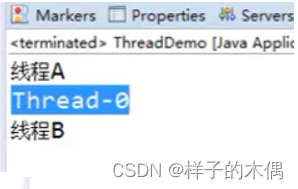
获取线程名称时,未命名线程会自动分配名称
接下来获取主线程名称
class mythread implementsRunable{@Overridepublicvoid run{System.out.println(Thrad.currentThread().getName());}}publicclassThreadDemo{publicstaticvoidmain(String[] args) throAws Exception{
mythread mt=newmythread();newThread(mt,"线程对象").start();//设置了线程名字
mt.run();//对象直接调用run()方法}}
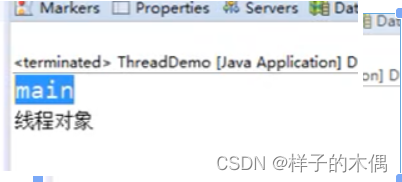
获取主线程名称为main(主方法也是线程)
线程休眠
我们可以希望某个线程能够暂缓执行以方便观察运行状态
在进行休眠的时候有可能会产生在进行休眠的时候有可能会产生
中断异常“InterruptedException”,中断异常属于Exception的子类,证明该异常必须进行处理
休眠方法:
- 休眠:public static void sleep(long millis) throws
InterruptedException; - 休眠:public static void sleep(long mills,int nanos) throws
InterruptedException;
范例:观察休眠处理(单个对象进行线程休眠处理)
publicclassThreadDemo{publicstaticvoidmain(String[] args)throwsException{newThread(()->{for(int x=0;x<10;x++){System.out.println(Thread.currentThrad().getName()+",x="+x);try{Thread.sleep(1000);暂缓执行
}catch(InterruptedException e){
e.printStackTrace();}}},"线程对象").start();}}
在线程的启动上有线程后,当程序休眠再启动也有先后,就像接力比赛,接棒时当作休眠,休眠后每个人的运行速度是不相同的,这就造成了线程执行完毕的先后顺序也是不同的
范例:产生多个线程对象进行线程处理
publicclassThreadDemo{publicstaticvoidmain(String[] args)throwsException{Runnable run=()->{for(int x=0;x<10;x++){System.out.println(Thread.currentThrad().getName()+",x="+x);try{Thread.sleep(1000);暂缓执行
}catch(InterruptedException e){
e.printStackTrace();}}};for(int num=0;num<5;num++){newThread(run,"执行线程"+num).start();}}}
线程休眠要通过运行代码自己观察
线程中断
在之前的线程休眠中发现里面提供有一个中断异常,这实际上证明线程休眠是可以被打断的,这种打断肯定是由其他线程完成的
在Thread类里面提供有线程处理方法
- 判断线程是否被中断:public boolean isInterrupted();
- 中断线程执行:public void interrupt();范例:观察线程的中断处理
publicclassThreadDemo{publicstaticvoidmain(String[] args)throwsException{Thread thread=newThread(()->{System.out.println("*****我需要休眠*****");try{Thread.sleep(10000);//休息10秒System.out.println("***睡足了,可以去工作了***");}catch(InterruptedException e){// TODO Auto-generated catch blockSystem.out.println("休息被打断");}});
thread.start();//开始休息Thread.sleep(1000);//先休息1秒钟if(!thread.isInterrupted()){//询问是否中断休息 //没有中断
thread.interrupt();//现在打断你的休息}}}
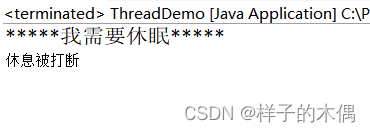
正在执行的线程都是可以被中断的,中断的线程必须进行异常处理
线程强制运行
当满足某些条件之后,某一个线程对象可以一直独占资源一直到线程结束
范例:观察一个没有强制执行的程序
publicclassThreadDemo{publicstaticvoidmain(String[] args)throwsException{Thread thread=newThread(()->{for(int x=0;x<100;x++){try{Thread.sleep(100);}catch(InterruptedException e){// TODO Auto-generated catch block
e.printStackTrace();}System.out.println(Thread.currentThread().getName()+"执行、x="+x);}},"玩耍的线程");
thread.start();for(int x=0;x<100;x++){Thread.sleep(100);System.out.println("霸道的main线程执行x="+x);}}}
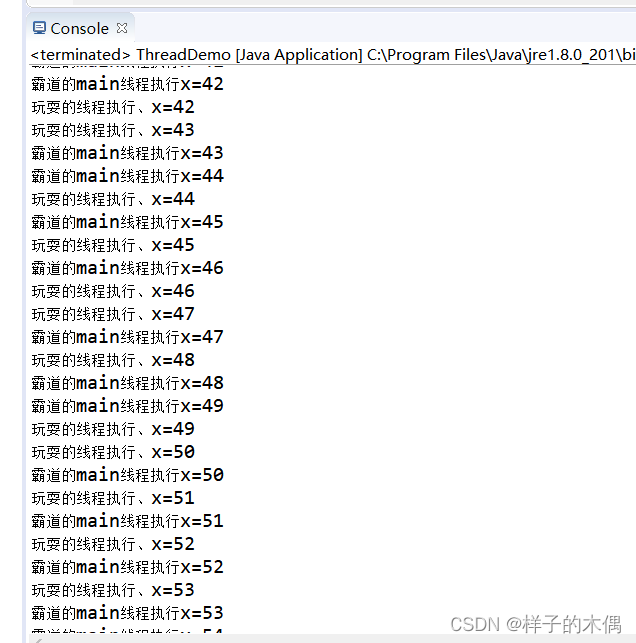
我们发现在子线程会和主线程抢占资源进行输出,接下来我们看看在利用了线程的强制执行后的运行状态
在Thread类里面提供有强制执行方法,join()方法
public final void join() throws InterruptedException
利用join()方法我们可以使线程强制执行独占资源
从强制执行抛出异常看出,强制执行也可以被中断
范例:强制执行程序
publicclassThreadDemo{publicstaticvoidmain(String[] args)throwsException{Thread mainThread=newThread().currentThread();//获取主线程Thread thread=newThread(()->{for(int x=0;x<100;x++){try{Thread.sleep(100);}catch(InterruptedException e){// TODO Auto-generated catch block
e.printStackTrace();}if(x>3){try{
mainThread.join();//霸道的线程开始执行}catch(InterruptedException e){// TODO Auto-generated catch block
e.printStackTrace();}}System.out.println(Thread.currentThread().getName()+"执行、x="+x);}},"玩耍的线程");
thread.start();for(int x=0;x<100;x++){Thread.sleep(100);System.out.println("霸道的main线程执行x="+x);}}}

可以看出当下x>3后main()开始独占资源,当main()执行完成后其他线程才开始执行
在进行强制执行的时候一定要获取强制执行线程对象才可以进行join的操作
线程礼让
在多线程中,可以先将资源让出去让别的线程先执行,线程的礼让可以用Thread中的方法
- 礼让方法:public static void yield();
范例:线程的礼让执行
publicclassThreadDemo{publicstaticvoidmain(String[] args)throwsException{Thread thread=newThread(()->{for(int x=0;x<100;x++){if(x%3==0){Thread.yield();//玩耍的线程礼让了System.out.println("****玩耍的线程礼让了*****");}try{Thread.sleep(100);}catch(InterruptedException e){// TODO Auto-generated catch block
e.printStackTrace();}System.out.println(Thread.currentThread().getName()+"执行、x="+x);}},"玩耍的线程");
thread.start();for(int x=0;x<100;x++){Thread.sleep(100);System.out.println("霸道的main线程执行x="+x);}}}
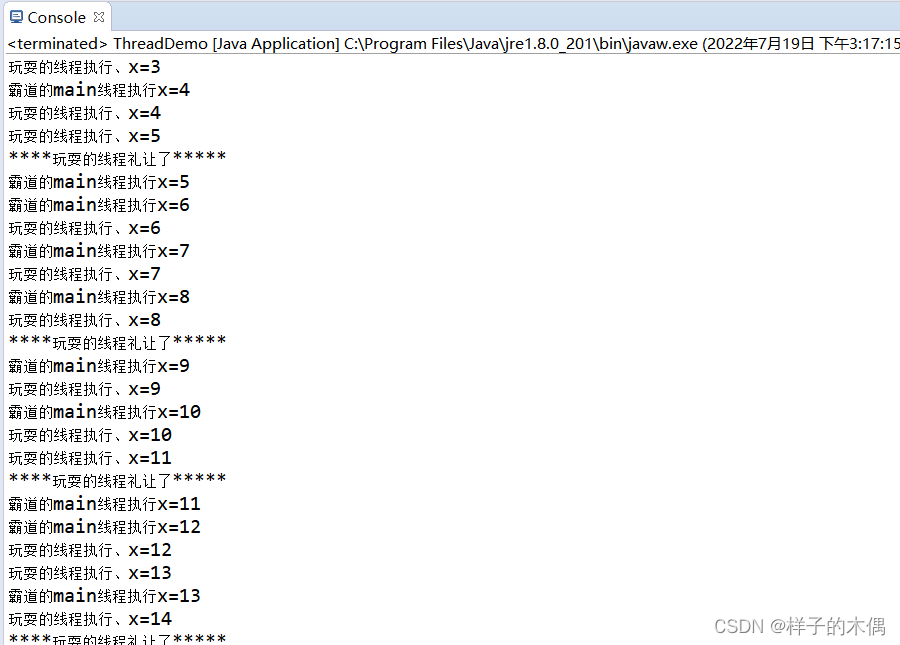
每一次调用yield()都只会礼让一次当前的资源
线程优先级
从理论上讲线程的优先级越高越有可能先执行(越有可能先抢占到资源)在Thread类里面提供有如下的两个处理方法
- 设置优先级:public final void setPriority(int newPriority);
- 获取优先级:public final int getPriority(); 在进行优先级定义的时候都是通过int型的数字来进行完成的,而对于此类数字的选择在Thread类里面就有定义
- 最高优先级:public static final int MAX_PRIORITY、10(优先级的值)
- 中等优先级:public static final int NORM_PRIORITY、5(优先级的值)
- 最低优先级:public static final int MIN_PRIORITY、1(优先级的值)
范例:没有设置优先级
publicclassThreadDemo{publicstaticvoidmain(String[] args)throwsException{Runnable run=()->{for(int x=0;x<10;x++){try{Thread.sleep(1000);}catch(InterruptedException e){// TODO Auto-generated catch block
e.printStackTrace();}System.out.println(Thread.currentThread().getName()+"执行");}};Thread threadA=newThread(run,"线程A对象");Thread threadB=newThread(run,"线程B对象");Thread threadC=newThread(run,"线程C对象");
threadA.start();
threadB.start();
threadC.start();}}

不同电脑效果不同,本人的是B优先执行
接下来看使用优先级后电脑执行的效果
范例:观察设置优先级后的效果
publicclassThreadDemo{publicstaticvoidmain(String[] args)throwsException{Runnable run=()->{for(int x=0;x<10;x++){try{Thread.sleep(1000);}catch(InterruptedException e){// TODO Auto-generated catch block
e.printStackTrace();}System.out.println(Thread.currentThread().getName()+"执行");}};Thread threadA=newThread(run,"线程A对象");Thread threadB=newThread(run,"线程B对象");Thread threadC=newThread(run,"线程C对象");
threadA.setPriority(Thread.MIN_PRIORITY);//把AB设置优先级最小
threadB.setPriority(Thread.MIN_PRIORITY);//把AB设置优先级最小
threadC.setPriority(Thread.MAX_PRIORITY);//把AB设置优先级最小
threadA.start();
threadB.start();
threadC.start();}}

提高有先级确实可以提高线程先执行的可能,但是并不是绝对先执行
补充:主方法是一个主线程,主线程的优先级是多少呢?
publicclassThreadDemo{publicstaticvoidmain(String[] args)throwsException{System.out.println(Thread.currentThread().getPriority());}}
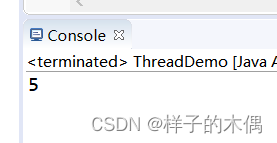
发现主线程的优先级是5,只是中等优先级,同时这与我们默认的方法的优先级是相同的
版权归原作者 样子的木偶 所有, 如有侵权,请联系我们删除。